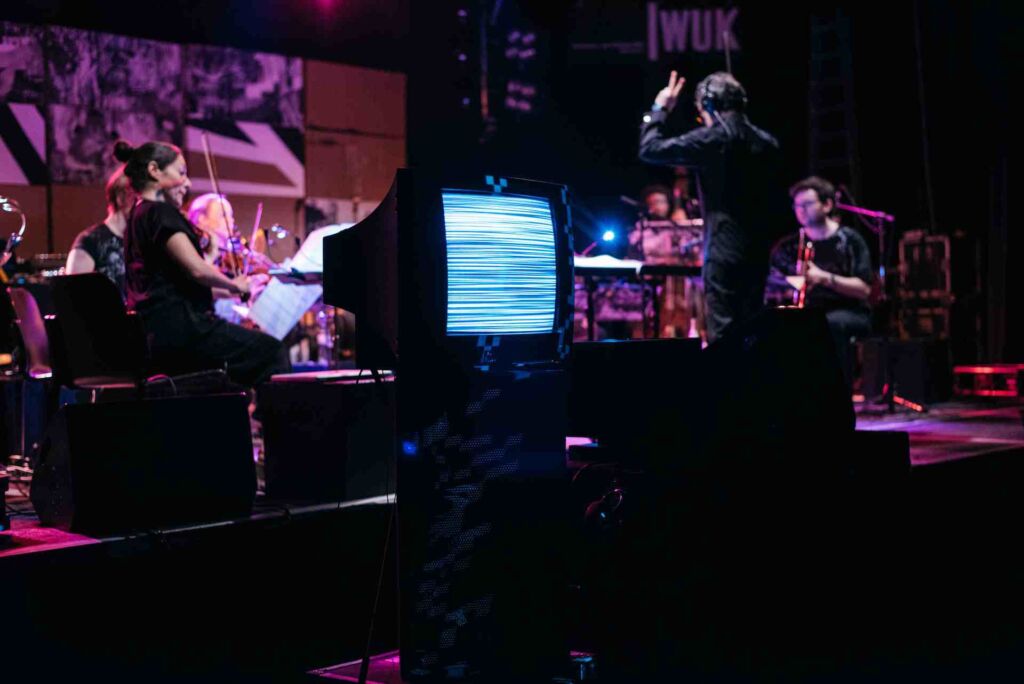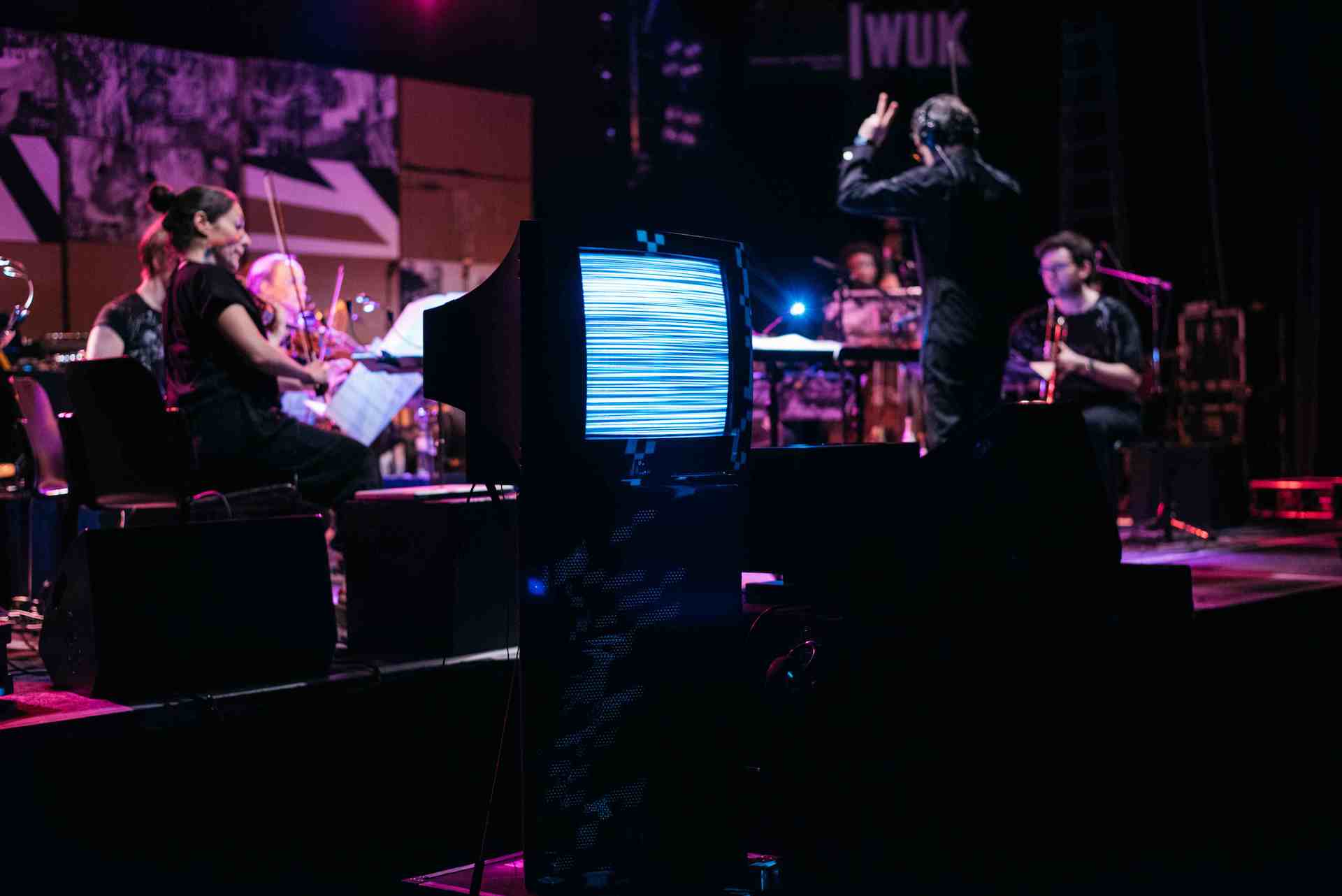Text by Olya Karlovich

This month, from July 6th to 9th, Heroines of Sound celebrates its 10th anniversary. Since 2014, Berlin’s festival team, led by art director and curator Bettina Wackernagel, has been striving to increase the visibility of female artists in the music and art scenes. Feminism, genre-spanning, and diversity are at the core of Heroines of Sound’s programming. In addition, each year, it’s dedicated to a special theme. Thus, the anniversary edition focuses on microtonality in its many manifestations and not only within the academic sphere.
Along with the performance of Pascale Criton, one of the leading representatives of spectral music, and a concert installation by Austrian sound pioneer Elisabeth Schimana, the visitors can experience the works of Maja Bosnić, who refers to the traditions of musique concrète, ‘exploring a spectrum of oscillating frequencies towards metallic hardness or raw noise’.
The Vienna Black Page Orchestra is in charge of the opening concert, during which they will also perform a piece by Rojin Sharafi, an Iranian sound artist, engineer, performer, and composer whose practice develops on the cusp of noise, ambient, contemporary and folk music. Among the international electronic scene representatives are Electric Indigo and Beatriz Ferreyra, an Argentine concrète composer active from the second half of the 20th century to the present day.
A significant role in the current programme is assigned to the electric guitar — acts such as Ale Hop and Maya Shenfeld present a compelling mix of the instrument and live electronics in their performances. At the same time, Catherine Lorent shows Relegation, the electro-magnetically controlled sound sculpture of seven electric guitars.
Noise, drone, musique concrète, folk, electric guitars, experimental electronics… Wackernagel notes that one of the key interests here has always been discovering unexpected correlations and hidden musical connections by explaining the main principles the festival curators took into account while compiling such a versatile and multi-genre programme.
This music has, at the core, a new tonal system. A system which is not equivalent to our classic notation [CLOT.: it uses intervals not found in the customary Western tuning]. […] I think this is an interesting aspect, and the idea is to invite the audience to experience these current sounds, see a little bit of the relations, and open up maybe a new context, she adds.

Heroines of Sound also constantly expands its geographical boundaries. Based in Berlin, however, the festival claims to be international in terms of programming and representation outside of Germany. This edition features more than 60 performers from 17 countries of origin. In addition, in cooperation with Errant Sound and Sonoscopia, it offers visitors an exhibition of current Portuguese sound art.
Heroines of Sound has long been not just a platform for concerts, but an extensive network and base for research with residences that helps artists, both well-known and newcomers, enhance, vary and share their profiles. Wackernagel says that last year, for example, the festival was commissioned to do a series of works for the legendary Minimoog synthesiser, which were then performed in Berlin, Copenhagen and Kiel.
For the artists, it was also very interesting. This synthesiser gives you a very unique sound. But it was also more used in the context of pop. So we started with the idea to give this sound a new stage in more contemporary classic or mixed formats, she adds.
This year’s programme also features enough interesting and even somewhat unexpected projects. Thus, the composer Stefanie Egedy, who explores the possibilities of low frequencies in her practice, is doing a collaboration with Ensemble KNM. Sharing the details of this performance, Wackernagel notes that she has known Egedy for ten years, but now the musician’s research ‘fits’ perfectly the festival theme.
I suggested [the collaboration with KNM], but, at the same time, we had to see first if it could work. Because she’s [Stefanie Egedy] a loud and extreme musician, they must be comfortable working together. So we had some meetings with KNM and Stefanie last December, and then they started talking a little bit, and it all worked fine.
Conceptual fit is one of the crucial aspects of the festival curatorial approach. Wackernagel shares that they receive many proposals from different artists every year, but not all of them can be accepted. We are not only a showcase festival. There’s always a connection between artists within the programme. Of course, there are many great performers. And although we appreciate their work, we can’t have everyone. Otherwise, it would be a total mix. And that is not our aim for programming. We always have a special focus, she explains.
Delving deeper into a specific theme, Heroines of Sounds explores it not only from the music and sound perspective. The festival opens to visual formats too. For example, in 2016, it celebrated the art of Mary Ellen Bute, a pioneer American film animator, producer, and director. She was one of the first female experimental filmmakers and applied the term ‘visual music’ to her pictures. As for the current edition, there will also be a film and video selection. One of the movies the festival visitors will see is A film about Listening (2021) by Sam Green, an Intimate portrait of the pioneering experimental composer and musician Annea Lockwood.

Generally, in her interviews, Bettina Wackernagel emphasises that it is very important for Heroines of Sound to ‘introduce a historic perspective’, so we can trace the boundaries and development of early electronic music. Maryanne Amacher, Pauline Oliveros, Laurie Spiegel, and others — many excellent female composers have become real musical innovators, but we still know very little about them.
Or, let’s take Pascal Criton, this year’s festival headliner, as an example. According to Wackernagel, despite her long and prolific career, Criton got more recognition in only the last few years. At the same time, the composer is barely presented in Germany, more so in France and the USA.
We’ve always been trying to create a genre-spanning and generation-spanning format, Wackernagel comments. To have as a role model somebody like Pascale Criton or Beatriz Ferreyra, a woman who has been continuously working and is now in her 70s or 80s is highly inspiring. And not only for female artists but also for men.
The rediscovery of early female protagonists in music is very important for broadening new perspectives. On the other hand, the idea of a festival with a predominantly female line-up can evoke thoughts of segregation. But this is definitely not the case with Heroines of Sound.
In the very beginning, there were prejudices. Many people thought that if our festival is feminist, then it would be a small niche. But with our successful performance, we have shown that the interest in our programming has reached a very broad, mixed, and diverse audience. We have many female artists, but when you look at the audience, it’s nearly 50/50. We are a feminist festival, but we’re not, we say, a women’s music festival. […] We don’t want to create only a female world, but we definitely want to overcome the crucial bias and strive for more diversity in the music scene. And this aim is not only dedicated to females. We all profit from this, Wackernagel emphasises.
But could we get closer to this kind of diversity in the scene Heroines of Sound aspire to? Bettina Wackernagel says that, of course, there are positive dynamics, but the changes are slow.
It seems to be a very long way to go. People say, well, it has changed so much, and that now they see more women… But I still sometimes receive strange remarks. For instance, one promoter told me that he is aware that there are great female artists, but it’s difficult to book them. Why is that so?! How do we succeed in booking artists like Electric Indigo or Beatriz Ferreyra, then?
And there are still many lineups with only male presence and classical programs with no female composers. And this is true in electronic, pop scenes…
However, the way Heroines of Sound has been developing and how quickly it has succeeded once again demonstrates that the issue of gender today is more relevant than ever, and the discussions around it are not at all abstract. Art is not afraid to be political, and feminism has long ceased to be perceived as an invention of radical man-haters, becoming an essential part of our culture.






